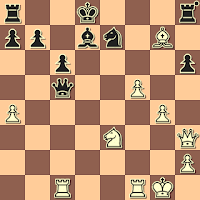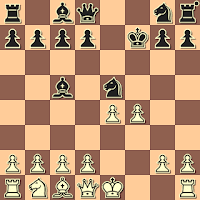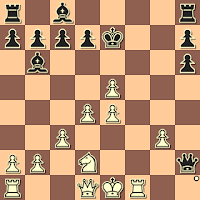The following game appears on a YouTube video "how to play jerome gambit ? how to play jerome ? jerome gambit chess ? chess traps ?" by TheMasterTricks.
The Queens on each side play a large part in the action (and the notes). Which King is more at risk changes, move by move.
Although there is no information on the time control, it appears to be a blitz game. Having more time in preparing this blog post, it is possible to do deeper analysis of this complicated game. The next time someone plays this game, it will be much more robust.
NN - NN
2022
1.e4 e5 2.Bc4 Bc5 3.Nf3 Nc6 4.Bxf7+
4...Kxf7 5.Nxe5+ Nxe5 6.f4
This move is relatively new and rare - The Database has only 4 previous examples. Most often, White plays 6.d4 or 6.Qh5+. Later, f2-f4 may occur.Is the move risky?
One indication is that at this point White resigned in danirovi - xtwozeroone, 5 0 blitz, FICS, 2014.
6...Qh4+
This is the strongest response. Apparently it has not been played before.
Previously seen;
6...Ng6 7.d4 Bb6 8.e5 Qh4+ 9.g3 Qh3 10.Be3 N8e7 11.Qd2 Nd5 12.Bf2 Qg2 13.Rg1 Qxh2 14.Nc3 Rf8 15.Nxd5 c6 16.Ne3 Re8 17.O-O-O d5 18.Rh1 Qxh1 19.Rxh1 Nf8 20.f5 g6 21.fxg6+ hxg6 22.c3 Bf5 23.Nxf5 gxf5 24.Qf4 Ke6 25.Rh6+ Kd7 26.Qxf5+ Kc7 27.Be3 Rad8 28.Bf4 Kb8 29.e6+ Bc7 30.Bg5 Rd6 31.Qf7 Rdxe6 32.Rxe6 Nxe6 33.Qxe8+ Bd8 34.Bxd8 a6 35.Qxe6 Ka7 36.g4 Black resigned, Darthnik - GregOakPark, 10 0 blitz, FICS, 2011;
6...Nc6 7.Qh5+ g6 8.Qd5+ Ke8 9.Qxc5 d6 10.Qe3 Nf6 11.O-O Qe7 12.d3 Bd7 13.Bd2 Rf8 14.Nc3 Kf7 15.Rae1 Kg8 16.e5 Nh5 17.e6 Be8 18.d4 Ng7 19.d5 Nd8 20.g4 c6 21.Qg3 b5 22.a3 a5 23.b4 axb4 24.axb4 Qa7+ 25.Be3 Qe7 26.Bd4 Ra3 27.Bxg7 Kxg7 28.f5 gxf5 29.gxf5+ Kh8 30.Kh1 Rg8 31.Qe3 Qf6 32.Ne4 Rxe3 33.Nxf6 Rxe1 34.Rxe1 Rf8 35.e7 Black resigned, Petasluk - Jirayu, 5 0 blitz, FICS, 2012;
6...Qf6 7.d4 d6 8.fxe5 dxe5 9.Rf1 Black resigned, vkmehta - herooftheday, 5 0 Blitz, FICS, 2012.
7.g3 Qh3
A much stronger response would be 7...Qg4, which requires a diagram.
analysis diagram
An exchange of Queens would leave White without much of an attack and a deficit of two pieces.
Back to the current game.
8.fxe5 Qg2 9.Rf1+ Ke7
Komodo 12.1.1 prefers 9...Ke8.
10.d4
White is strugging to get out of a difficult situation.
Komodo 12.1.1 recommends some tactical cut-and-thrust, followed by a draw: 10.Qg4 Kd8 11.d4 d5 12.Qg5+ Ne7 13.dxc5 Qxe4+ 14.Be3 d4 15.Nc3 Qxe3+ 16.Qxe3 dxe3 17.Rd1+ Ke8 18.Nb5 Ng6 19.Nxc7+ Ke7 20.Nd5+ Kd8 21.Nb6+ Ke7 22.Nd5+ draw by repetition.
The text move would be the solution, if there were not one line that favors Black.
10...Bb6
Black's wandering Queen misses 10...Qxe4+ 11.Qe2 Qxe2+ 12.Kxe2 Bxd4 and, with Queens off of the board, he is doing fine.
11.c3
The move 11.Qg4 would show the danger Black's King is in, for example 11...Ke8 (11...Bxd4 falls to 12.Qxg7 which leads to mate) 12.Be3 (White has time to afford this reinforcement of his center) g6 13.Qf4 and Black will have to give up material.
11...Nh6
Defensive minded. Black would have done better pressuring the enemy monarch with 11...Qxe4+ 12.Kf2 d6!? when his King can dance away from danger, for example 13.Bg5+ Ke8 or 13.exd6+ Kf7 14.Kg1+ Nf6.
12.Bxh6
This is a familiar move for Jerome Gambit players. It can be the start of clearing out the Queenside pieces for Queenside castling. White's King craves safety.
Still, he had a line that would be scarier for Black's King: 12.Bg5+ Ke8 13.Qh5+ g6 14.Qxh6 because White's King can run for his life, leving the first player better: 14...Qxe4+ 15.Kd1 Qg4+ 16.Kc2 d6 17.Qg7 Bf5+ 18.Kb3 Qxg5 19.Qxh8+ Kd7 20.Qxa8.
12...gxh6
Reasonable reflex reaction. Instead, 12...Qxe4+ gave chances for a balanced, if chaotic, game.
13.Nd2
Still thinking defense, looking to 0-0-0. Not everyone would think like the computer and look to 13.Qg4 Ke8 14.Qh5+ Kd8 15.Qh4+ Ke8 16.Nd2
13...Qxh2
This move gives up any chance to play ...Qxe4+, and defuses some of Black's attacking chances.Komodo 12.1.1 suggests a high anxiety line, instead, leading to a draw by repetition: 13...Rf8 14.Qg4 Rxf1+ 15.Nxf1 Qxb2 16.Qg7+ Ke8 17.Qg8+ Ke7 18.Qxh7+ Kd8 19.Qh8+ Ke7 20.Qf6+ Ke8 21.Qg6+ Kd8 22.Qf6+ Ke8 etc.
Now White finishes things off.
14.Qf3 Ke8 15.Qf7+ Kd8 16.Qf6+ Ke8 17.Qxh8+ Ke7 18.Qxh7+ Ke6 19.Qf7 checkmate
It is not clear from the video who played this game, but I hope that it was two computer chess programs. A human being on either side of the board would risk a panic attack.










































